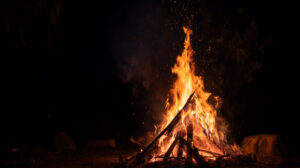Let’s Celebrate


I t’s the morning after the chasunah and I’m in that morning-after-the-chasunah state of being. It’s the one where you’re no longer feeling yourself sailing in the highest heavens but still comfortably pleasurably ensconced on a slightly lower cloud still awash in the after-emotions of the evening prior — the exaltedness the sheer delight the fleeting moments when a glimmer of the Next World broke through into This One.
No I didn’t celebrate the marriage of a child last night. But I was at a wedding a union of hearts and minds and souls. Not only one such union but many.
Last night here in Jerusalem hundreds of young men with shining faces from a diverse range of backgrounds and yeshivos — some 30 in all — gathered at the city’s Ramat Tamir Hall. They came together under the banner of V’Haarev Na — the program initiated by Rabbi Dovid Newman that is surely one of the greatest things happening in the Torah world today — for a grand siyum on five different masechtos.
They came to dance and sing to feast and schmooze to inspire and to get inspired to be propelled onward upward. They arrived for a chasunah — theirs.
Many things go into the making of a simchah: a mesader kiddushin mechutanim music to name a few — and all were present last night. But at the very center of it all are the chassan and kallah and if every one of these boys was a chassan then the holy Torah was the kallah.
But doesn’t every chassan have his own kallah? Of course. And so it was on this evening too.
On the pasuk in Tehillim (1:2) “Ki im b’soras Hashem cheftzo uv’Soraso yehegeh yomam valaylah ” Chazal (Kiddushin 32b) note that the Torah is referred to first as Toras Hashem and then as Soraso the personal Torah of one who learns it because once a Jew learns Hashem’s Torah it is transformed into Torah dilei a Torah of that Jew’s very own. And last night every member of V’Haarev Na had his individual kallah with him kallah dilei.
How after all do you make Hashem’s Torah your own? The answer says Dovid HaMelech is “Uv’soraso yehegeh yomam valaylah ” by learning it “day and night ” at out-of-the-ordinary times: On ski trips and cross-country treks; before after and in-between sedarim; and over a bein hazmanim — like the young man they spoke of last night who learned 327 blatt over one such Yom Tov break. And in unusual sorts of places too: While sitting in the dentist’s chair (having a cavity filled) or waiting for the barber’s chair or while winging it to Eretz Yisrael (time enough apparently for chavrusas to finish all of Succah’s 55 blatt). V’Haarev Na guys have done all of the above and then some.
This chasunah had its mesader kiddushin too. Guest speaker Rav Yosef Elefant the renowned rebbi of so many in Yeshivas Mir explained why the V’Haarev Na formula of “Chazarah chazarah chazarah and then? More chazarah!” generates a certain kedushah that’s uniquely protective of the Torah learner long after he has closed the Gemara. Torah learning that’s out-of-the-box defying the limitations of time and space writes the Maharal affords protection that is similarly transcendent.
Rav Elefant cited the observation of the Sfas Emes that the Chanukah menorah’s position to the left as one enters the home means it is on one’s right as he exits to the outside. Of the Greeks whose salient middah was azus brazenness it is said “U’fortzu chomos migdalai” — they trampled every boundary entering and polluting the precincts of the holy. But we in turn engage in spiritual pushback asserting an azus of our own a sacred brazenness to bring kedushah out of those very precincts of the holy and extend Torah’s reach beyond the daled amos shel halachah and into the street (or at least the barbershop). On our way out of the hallowed confines of the Jewish home we pause to turn rightward toward the menorah and gaze at its pure flames girding ourselves with their holy light for what awaits us outside.
Standing behind everything that took place on this magical evening were the “parents” — the father and mother of V’Haarev Na which in this case are embodied in one individual Rabbi Dovid Newman. He has become synonymous with the idea that when Gemara is transmitted to bochurim in a way that enables them to master it and review it until it’s “in the bones ” there’s nothing — not sports nor technological trinkets nor anything else out there — that can compete with the sense of fulfillment that Torah provides.
How can it be that the law of diminishing returns dictating that the more frequently a pleasure is experienced the less enjoyable it becomes applies to every pleasure known to man except for one — the study of Torah which becomes increasingly pleasurable with each successive review? It’s because Torah possesses a quality the entire spectrum of This World’s illusory and momentary pleasures does not Torah is real and hence lasting and the further one journeys into its heart the more that reality is amplified.
Reb Dovid believes in the power of Torah and he believes in his boys and through him they too come to believe in themselves and in what Torah — learned with clarity and reviewed unendingly — can do for them and to them. Once they taste it for themselves they become V’Haarev Na’s most effective ambassadors to other talmidim and thus does a movement a revolution flourish.
Joining in the celebration were the mechutanim the rebbeim who came from all over America and Eretz Yisrael to see their talmidim in their moment of triumph as they stood and recited the words of the hadran in unison. And at one special table were seated yet other mechutanim a group of balebatim from Ramat Bet Shemesh who belong to one of three chaburos there — which are among the many Kinyan Hamasechta groups for balebatim around the globe that are successfully following the V’Haarev Na approach.
Rabbi Avi Schneider who heads one of these chaburos shared an anecdote that begs retelling. “The chaburah was learning Maseches Succah and upon reaching daf nun gimmel we encountered the word achvei. A member of the group named Daniel Esses mentioned offhandedly that this word was to be found only twice in this masechta here and on daf yud tes. I was skeptical and told him I’d verify his claim using the Bar Ilan CD containing all of Shas. Sure enough my search turned up three references to that word in Succah and when I saw him next I remarked about how impressed I was that he’d been off by only one. He however stood his ground insisting that the Bar Ilan site was mistaken. And upon further investigation he was right….”
I’d heard stories similar to this one at Shabbos afternoon Pirchei groups long ago about Jews who lived long ago — but certainly not about a balebos in Ramat Bet Shemesh. And that is truly cause for celebration.
Originally featured in Mishpacha Issue 689. Eytan Kobre may be contacted directly at kobre@mishpacha.com
Oops! We could not locate your form.












